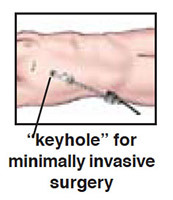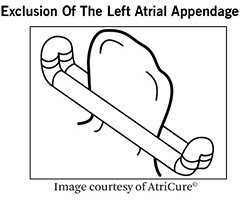What is atrial fibrillation?
Atrial fibrillation (AF or AFib) is the most common irregular heart rhythm in the United States. Atrial fibrillation is an abnormal heart rhythm that starts in the top chambers of the heart (atria). Instead of the impulse traveling in an orderly fashion through the heart, many impulses begin at the same time and spread through the atria, causing a rapid and disorganized heartbeat.
At one time, atrial fibrillation was thought to be a harmless annoyance. However, the condition is now considered to be dangerous. If you have atrial fibrillation, your risk of dying is doubled, and you are 5 to 7 times more likely to have a stroke compared to a person without atrial fibrillation. The condition may also cause congestive heart failure and uncomfortable symptoms related to a fast heart rate.
Treatment for patients with atrial fibrillation
The goals of treatment for patients with atrial fibrillation are to restore a normal heart rhythm (sinus rhythm), control the heart rate, prevent blood clots and reduce the risk of stroke.
Medications
Most patients begin treatment with medications such as:
- Rhythm control medications (anti-arrhythmic drugs) to help get your heart back into a normal sinus rhythm and keep the rhythm normal.
- Rate control medications to slow your heart rate during atrial fibrillation.
- Rhythm or rate control medications along with an anticoagulant ("blood-thinner") to prevent blood clots and stroke.
Surgical treatment
Your doctor may recommend surgery if:
- You can’t take medications as part of your treatment plan.
- Your symptoms of atrial fibrillation continue, even after taking medications as treatment.
- You have blood clots or a stroke.
- You need surgery for another heart problem, such as valve or coronary artery disease.
Evaluation
Before surgery is recommended, you will have an evaluation that includes:
- A review of your medical history.
- Complete physical exam.
- Electrocardiogram (ECG).
- Echocardiogram (echo).
- Holter monitor test.
- Other tests, if needed.
After the evaluation, the surgeon will talk to you about your treatment options and whether you are a candidate for surgery.
Who is a candidate for surgery?
Cleveland Clinic surgeons have vast experience in the ablation (cure) of atrial fibrillation and use the most current treatment options. Because of this, most patients are able to have surgical treatment, if needed.
Patients with atrial fibrillation who are considered for surgical ablation fall into two groups:
- Patients with isolated atrial fibrillation (do not need another type of heart surgery) may be candidates for minimally invasive (endoscopic or "keyhole") treatment approaches or the Maze procedure.
- Patients with atrial fibrillation who need heart surgery for another reason, such as coronary artery disease or valve disease.
What are the risks of surgery for atrial fibrillation?
Surgical treatments for atrial fibrillation are generally very safe. But, there are risks with all types of procedures. Special precautions are taken to reduce these risks. Your doctor will talk to you about the risks of your procedure and anesthesia used during surgery. Do not hesitate to discuss any questions or concerns you have.
Surgery for patients with isolated atrial fibrillation
Minimally Invasive Approach

Patients with atrial fibrillation that comes and goes (paroxysmal atrial fibrillation) are candidates for ablation that uses a minimally invasive technique. Your surgeon may use a keyhole surgery or completely endoscopic approach.
The surgery involves isolating the pulmonary veins and the left atrial appendage. Radiofrequency energy is used to create scar tissue, which blocks the abnormal impulses that cause atrial fibrillation. With these circuits blocked, the heart can return to a normal sinus rhythm.
How is minimally invasive surgery different from traditional heart surgery?
Minimally invasive surgery uses small incisions and specialized tools. An endoscope is used to look at the outer surface of the heart (epicardium). The surgeon does not need to make a large chest incision or stop your heart during surgery for treatment of atrial fibrillation. This results in less time for surgery and recovery.
Minimally invasive surgery for atrial fibrillation also reduces some risks, such as the risk of pulmonary vein stenosis, blood clots and stroke.
The Maze procedure
Some patients with isolated atrial fibrillation, especially continuous atrial fibrillation and/or enlarged atria, are candidates for the Maze procedure. The procedure can cure atrial fibrillation and restore the atria to a more normal size.
During the Maze procedure, several incisions are made in the right and left atria to block abnormal impulses that cause atrial fibrillation. This restores a normal pathway for impulses to travel to the atrioventricular node (AV node). The procedure cures atrial fibrillation in 70% to 85% of patients.
The Maze procedure requires an incision along the breast bone (sternum). The incision may be traditional (about 6 to 8 inches long), or minimally invasive (about 3 to 5 inches long). The heart-lung machine is used during the procedure to keep oxygen-rich blood moving throughout your body.
Exclusion of the left atrial appendage

The left atrial appendage (LAA) is a small, ear-shaped tissue flap located in the left atrium. It is common for blood clots to form in the LAA if you have atrial fibrillation. During surgery for atrial fibrillation, the LAA is removed and the tissue is closed with a special device.
Surgery for patients with atrial fibrillation who need surgery for another heart problem
Atrial fibrillation is very common in patients who need surgery for another heart problem, such as mitral valve surgery, aortic valve surgery and coronary artery bypass grafting (CABG). Cleveland Clinic surgeons often combine surgery for atrial fibrillation with these procedures.
Surgeons may perform either a classic Maze procedure or a modified Maze procedure. The classic Maze procedure takes about an hour to complete, so most times a modified Maze procedure is used when more than one surgery is needed. The modified procedure takes 15 to 20 minutes and cures atrial fibrillation in 70 to 85% of patients.
If you have valve disease and atrial fibrillation, you may be a candidate for minimally invasive surgery to correct both conditions.
Modified Maze procedure
Rather than the incisions used in the traditional Maze procedure, the modified Maze procedure uses alternative energy to create scar tissue. The scar tissue blocks abnormal electrical impulses in the heart. This restores a normal pathway for impulses to travel to the atrioventricular node (AV node).
A small incision is made in the left atrium, and an energy probe is inserted. Types of energy used in this procedure include radio frequency and cryothermy/cryoablation, which uses very cold temperatures.
What to expect after surgery
Recovery
You will begin your recovery in a specialized intensive care unit (ICU). After 1-2 days, you will continue your recovery on a nursing unit.
While you are in the hospital, we will closely monitor your heart rate and rhythm, blood pressure, blood oxygen level and other vital signs. Please do not hesitate to ask a member of your healthcare team if you have any questions or concerns about your care.
Most patients stay in the hospital 5-7 days after surgery. If you had minimally invasive surgery, you may be able to go home 3-4 days after your procedure. These are only guidelines, and your personal recovery may be shorter or longer depending on your needs.
It will take 6-8 weeks to fully recover from surgery, and you will get information about ways to help your recovery, incision care, signs of infection and other problems, and activity restrictions after surgery.
Medications
Your nurse will talk to you about the medications you need to take after surgery. These may be different than the medications you took before surgery. Make sure you ask any questions you have about the types and amounts of medications to take and/or when to take them.
Common medications after surgery for atrial fibrillation include:
- Anticoagulant (blood thinner), such as Coumadin, to prevent blood clots.
- Antiarrhythmic medication to control abnormal heartbeats.
- Diuretics to get rid of extra fluid in your body.
- Other medications, as needed.
Your doctor will let you know how long you need to take these medications.
Abnormal heartbeats
Up to half of all patients who have surgery to correct atrial fibrillation have skipped heartbeats or short episodes of atrial fibrillation during the first 3 months after surgery. These abnormal heartbeats are caused by swelling of the atria, and usually stop after the heart is healed. In the meantime, medication is used to treat the problem.
In some cases (about 5%-10% of patients), a pacemaker is needed after surgery because there is a previously undetected rhythm problem, such as sick sinus syndrome or heart block.
Surgery success rates
Surgery is an effective way to treat patients with atrial fibrillation. Success rates are 80%-90% for patients with isolated atrial fibrillation and 70 to 85% for patients who have combined heart surgery.
After surgery, the majority of patients have:
- Long-term freedom from atrial fibrillation.
- Fewer symptoms related to atrial fibrillation.
- Fewer blood clots and lower risk of stroke.
- Smaller-sized atria, if atria were large before surgery. This is especially true for patients who have a Maze procedure plus mitral valve repair surgery.